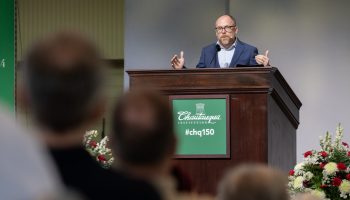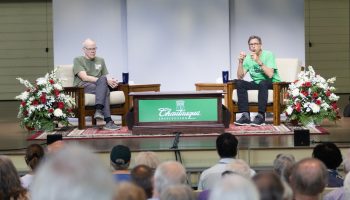
Since she arrived at Chautauqua Institution in 2015, Supervisor of Gardens and Landscapes Betsy Burgeson has been leading a green revolution of the gardens on the grounds, encouraging a diversity of plants that will provide a home for a variety of wildlife.
“Sustainable doesn’t even do it justice,” she said. “They’re protective in a way. Are we focusing on habitat for birds, butterflies, for the insects from the lake so they could maybe eat the mosquitoes?”
For this green revolution, Burgeson said she considers whether plants are native and whether they have deep root structures that will help hold soil in place. She also considers plant diversity, in order to provide habitat for a wide range of wildlife.
“You shouldn’t only see flowers,” she said. “That’s not a healthy garden to me. … You should be able to see all sorts of life around it.”
Burgeson, along with Institution Archivist and Historian Jon Schmitz, will discuss the gardens of Chautauqua at 3:30 p.m. Tuesday, July 9 in the Hall of Christ, as part of the Oliver Archives Heritage Lecture Series.
Schmitz will present a history of the gardens on the grounds since Chautauqua’s inception. He said Chautauqua has always been deeply tied to nature, serving as a haven for people who wanted a break from the city.
As supervisor of gardens and landscapes, Burgeson maintains 325 garden beds on the grounds. In each of those 325 beds, she has attempted to introduce more native plants, and plants like milkweed, which are a food source for monarch caterpillars and provide habitat for Monarch butterflies.
She has also implemented a number of rain gardens, which are designed to capture and filter rainwater, slowing it down and cleaning it before it reaches Chautauqua Lake. Water that has had a chance to filter typically has lower phosphorus and nitrogen levels, which are two nutrients that have caused problems with algal blooms and an overabundance of aquatic plant growth.
“Chautauqua Institution is trying to really expand and become more internationally known and intertwined with everything that’s going on around it nationally and internationally,” she said. “And it’s the same concept with the gardens. If we do our part here, we can make a huge impact.”
Burgeson said she hopes Chautauquans who observe the gardens and attend the Bird, Tree & Garden Club talks will be inspired to grow more environmentally conscious gardens outside their homes.
The talk will also discuss the reinstallation of the gardens around the Miller Edison Cottage.

Tom Hagen purchased the Miller Edison Cottage from the Arnn family and donated the cottage to the Institution in 2016. Schmitz dug up plans, dated 1922, for the gardens around the cottage, which were drawn up by groundbreaking female landscape architect Ellen Biddle Shipman. The plans were commissioned by Mina Edison, who was living in the cottage at the time.
With the help of a Connecticut-based Heritage Landscape architecture firm, Burgeson adapted the plans to recreate the gardens as much as she could, while making them practical for the current day.
The original plans were incredibly ambitious, Burgeson said, including three to four thousand plants in the design. The number of plants was halved for the reboot of the garden in order to prevent overcrowding.
“In 1922, they didn’t really know about invasives at that point,” Burgeson said.
Last fall, the gardens crew dug out about 400 plants from the garden and fostered them in a greenhouse throughout the winter. Three hundred survived the winter and were replanted in the garden.
Round one of planting is almost complete, Burgeson said. In the fall, the crew will continue to plant ferns, bulbs and some woodland plants such as woodland orchids.
While the planting of the garden is nearing completion, Burgeson said she is excited to see how the garden will fill in next year.
“Just like with any garden, it’s the excitement of the next year,” she said. “I’ve seen how much a garden fills in. It gives you hope for the next year. It gives you something to look forward to.”




